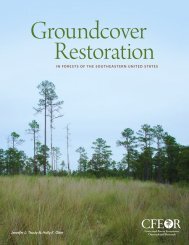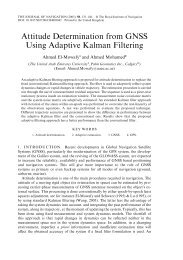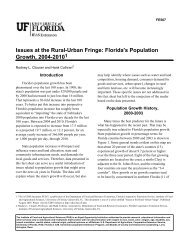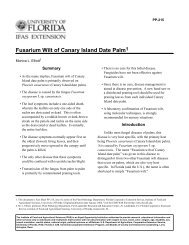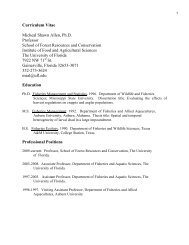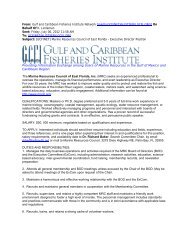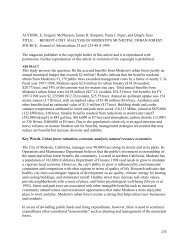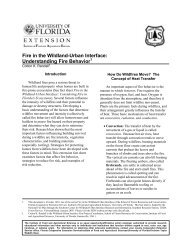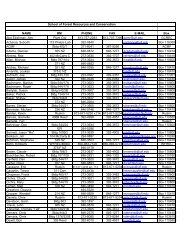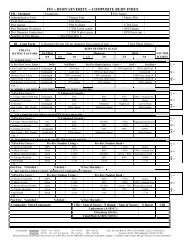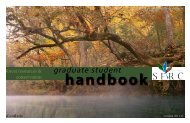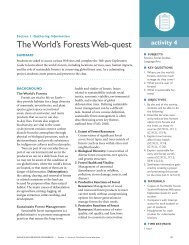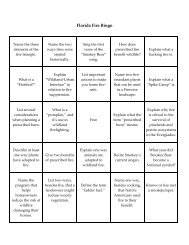Longleaf Pine Forest Restoration & Management - School of Forest ...
Longleaf Pine Forest Restoration & Management - School of Forest ...
Longleaf Pine Forest Restoration & Management - School of Forest ...
Create successful ePaper yourself
Turn your PDF publications into a flip-book with our unique Google optimized e-Paper software.
SS-FOR-13<br />
<strong>Longleaf</strong> <strong>Pine</strong> Regeneration 1<br />
Chris Demers, Alan Long and Patrick Minogue 2<br />
<strong>Longleaf</strong> pine (Pinus palustris) has many<br />
favorable characteristics for landowners who have<br />
long-term, multiple-use resource management<br />
objectives. Of all the southern pine species, longleaf<br />
pine is the most insect-, disease-, and fire-resistant<br />
and has the greatest longevity. When burned<br />
regularly, longleaf pine forests develop a stable grass<br />
savannah ecosystem, providing ideal habitat for many<br />
plants and animals.<br />
<strong>Longleaf</strong> pine is a pioneer species on a variety <strong>of</strong><br />
sites but is intolerant <strong>of</strong> competition and flooding<br />
during its grass stage, when it appears like a clump <strong>of</strong><br />
grass. Historically, fire and moisture have been the<br />
principal factors controlling longleaf distribution<br />
within its natural range. In the lower Coastal Plain<br />
longleaf grows on sandy, well-drained to excessively<br />
well-drained soils where loblolly or slash pine<br />
perform more poorly. Fire removes competing<br />
vegetation, exposing the bare soil necessary for<br />
successful seedling establishment. In the historic<br />
fire-dominated longleaf pine grass savannah<br />
ecosystem, relatively stable plant communities are<br />
characterized by an overstory <strong>of</strong> uneven-aged, widely<br />
spaced longleaf pines and fire-tolerant oaks such as<br />
bluejack oak (Quercus incana) and turkey oak<br />
(Quercus laevis) and a predominate ground cover <strong>of</strong><br />
bunch grasses such as wiregrass (Aristrada stricta)<br />
and bluestems (Andropogon spp) which facilitate<br />
ignition and spread <strong>of</strong> periodic fires (Landers 1991).<br />
It is interesting to note that, despite this tree's<br />
performance on high, dry ground, its Latin name<br />
means "swamp pine." It does grow sparsely in wet<br />
areas as well.<br />
Artificial Regeneration<br />
Options for artificial regeneration include<br />
planting <strong>of</strong> bareroot or containerized seedlings or<br />
direct seeding. Control <strong>of</strong> pine stocking (density) is<br />
best when seedlings are planted and container-grown<br />
seedlings generally provide the best survival rate.<br />
However, direct seeding may be a viable option for<br />
some situations, such as regenerating relatively small<br />
areas.<br />
Site Preparation<br />
<strong>Longleaf</strong> pine is very intolerant <strong>of</strong> shade and is<br />
difficult to regenerate successfully without<br />
1. This document is SS-FOR-13, one <strong>of</strong> a series <strong>of</strong> the <strong>School</strong> <strong>of</strong> <strong>Forest</strong> Resources and Conservation, Florida Cooperative Extension Service, Institute <strong>of</strong> Food<br />
and Agricultural Sciences, University <strong>of</strong> Florida. First published January 2000. Reviewed August 2006; revised November 2010. Please visit the EDIS<br />
website at http://edis.ifas.ufl.edu.<br />
2. Chris Demers, forest stewardship coordinator; and Alan Long, former pr<strong>of</strong>essor, <strong>Forest</strong> Operations and Environmental Regulations; and Patrick Minogue,<br />
assistant pr<strong>of</strong>essor, Silviculture, Cooperative Extension Service, Institute <strong>of</strong> Food and Agricultural Sciences, University <strong>of</strong> Florida, Gainesville 32611.<br />
The use <strong>of</strong> specific trade names in this publicaiton does not constitute endorsement <strong>of</strong> these products in preference to others containing the same active<br />
ingredients. Mention <strong>of</strong> a proprietary product does not constitute a guarantee or warrranty <strong>of</strong> the product by the authors or the publisher.<br />
All chemicals should be used in accordance with directions on the manufacturer's label.<br />
The Institute <strong>of</strong> Food and Agricultural Sciences (IFAS) is an Equal Opportunity Institution authorized to provide research, educational information and<br />
other services only to individuals and institutions that function with non-discrimination with respect to race, creed, color, religion, age, disability, sex,<br />
sexual orientation, marital status, national origin, political opinions or affiliations. U.S. Department <strong>of</strong> Agriculture, Cooperative Extension Service,<br />
University <strong>of</strong> Florida, IFAS, Florida A. & M. University Cooperative Extension Program, and Boards <strong>of</strong> County Commissioners Cooperating. Millie Ferrer-<br />
Chancy, Interim Dean



